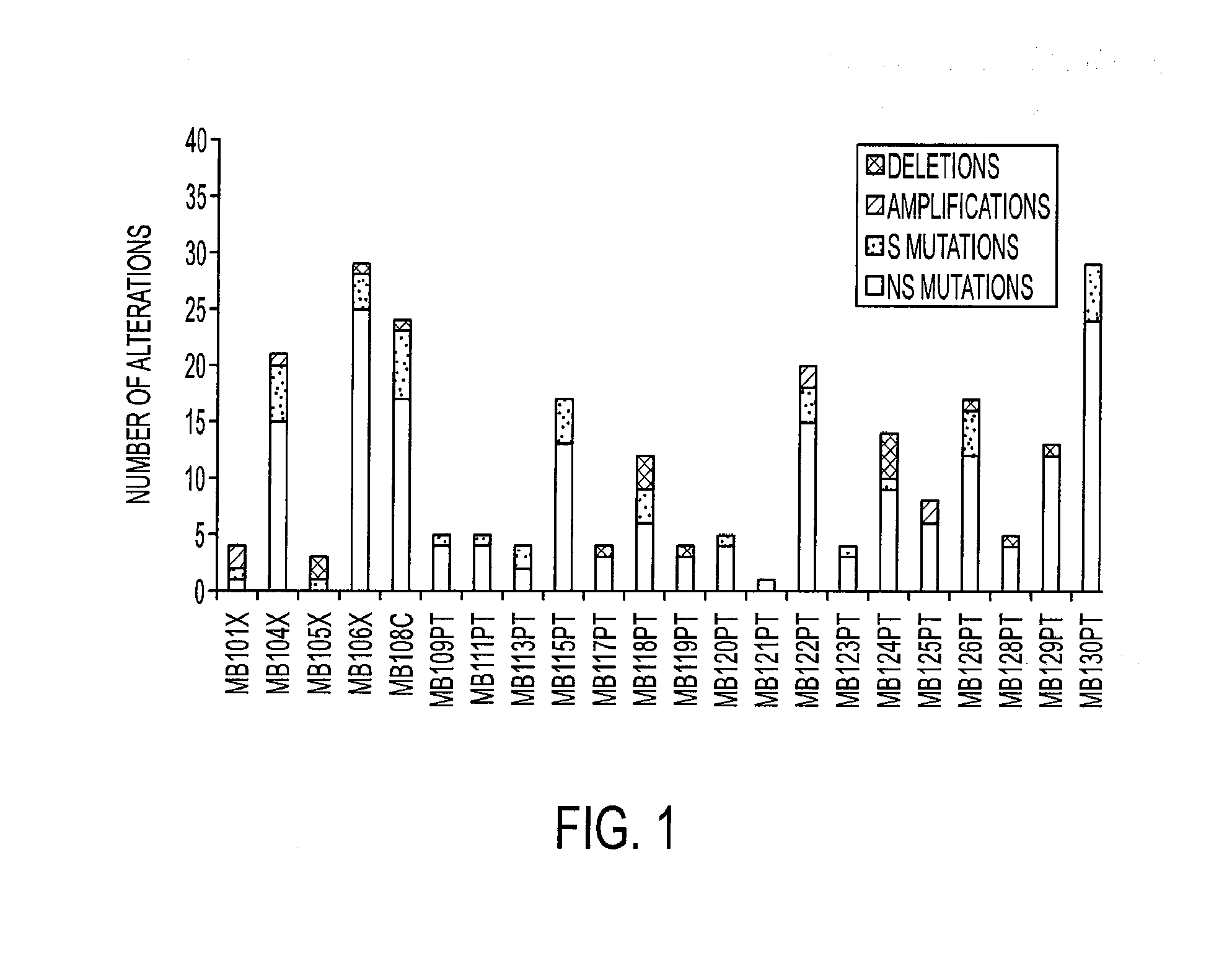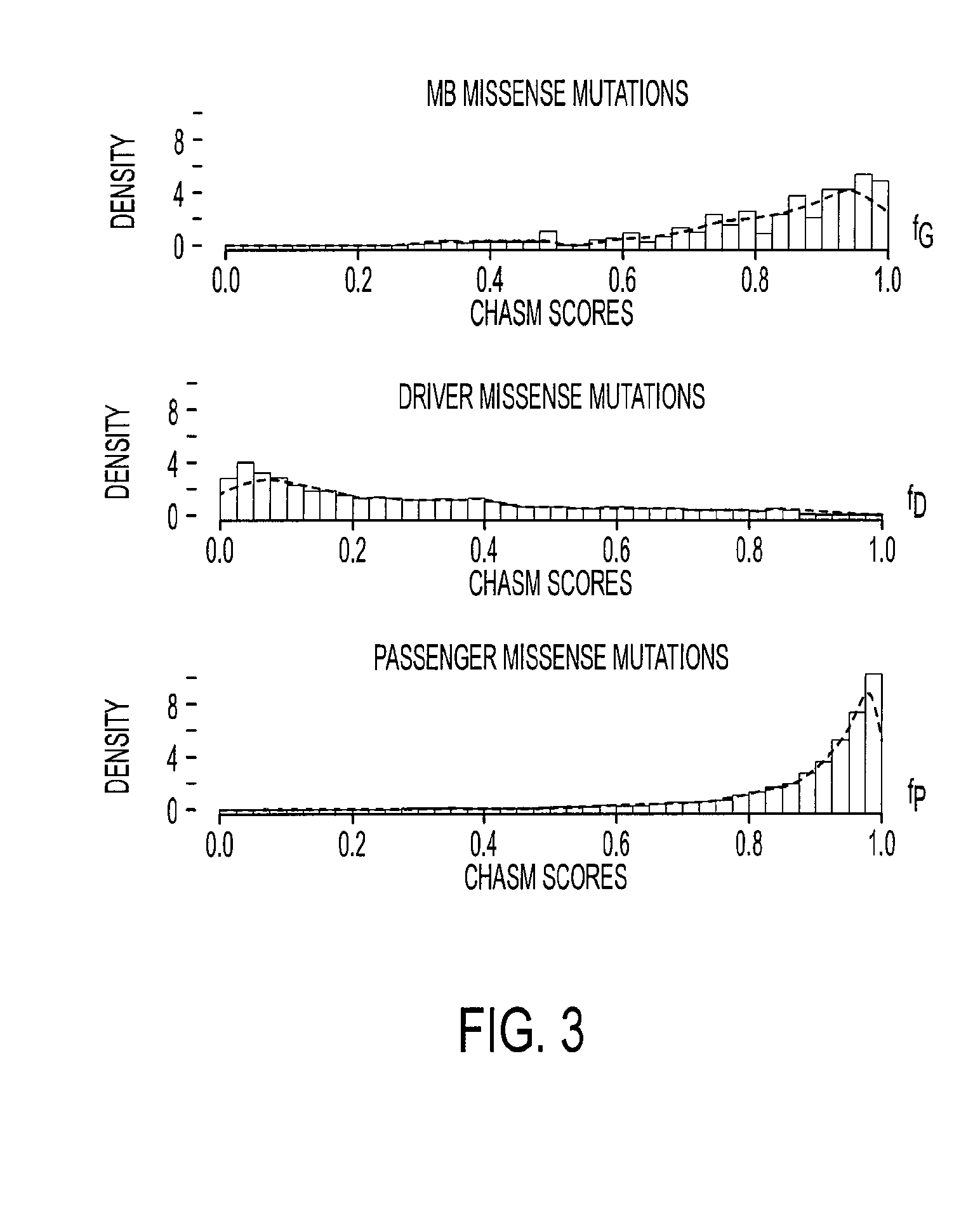Medulloblastoma genes as targets for diagnosis and therapeutics
a technology of mb and genes, applied in the field of child cancer, can solve the problems of unrecognized gene database and significant treatment-related morbidities of survivors, and achieve the effect of increasing or decreasing the efficacy of the candida
- Summary
- Abstract
- Description
- Claims
- Application Information
AI Technical Summary
Benefits of technology
Problems solved by technology
Method used
Image
Examples
example 1
[0049]The determination of the human genome sequence and improvements in sequencing and bioinformatic technologies have recently permitted genome-wide analyses of human cancers. To date, the sequences of all protein-encoding genes have been reported in 83 human cancers (9-20), representing a variety of adult tumors. In this study, we provide the first comprehensive sequence analysis of a solid tumor of childhood. Our data point to a major genetic difference between adult and childhood solid tumors and provide new information to guide further research on this disease.
Sequencing Strategy
[0050]In the first stage of our analysis, called the Discovery Screen, 457,814 primers (table S1) were used to amplify and sequence 225,752 protein coding exons, adjacent intronic splice donor and acceptor sites, and miRNA genes in 22 pediatric MB samples and one matched normal sample (table S2). These analyses corresponded to 50,191 transcripts representing at least 21,039 protein encoding genes prese...
example 2
Analysis of Sequence and Copy Number Alterations
[0052]A total of 225 somatic mutations were identified in this manner (Table 1 and Table S3). Of these, 199 (88%) were point mutations and the remainder were small insertions, duplications or deletions, ranging from 1 to 48 bp in length. Of the point mutations, 148 (74%) were predicted to result in non-synonymous changes, 42 (21%) were predicted to be synonymous, and 9 (5%) were located at canonical splice site residues that were likely to alter normal splicing. 36 of the 225 (16%) somatic mutations were predicted to prematurely truncate the encoded protein, either through newly generated nonsense mutations or through insertions, duplications or deletions leading to a change in reading frame. The mutation spectrum observed for MB was similar to those seen in pancreatic, colorectal, glial and other malignancies (22), with 5′-CG to 5′-TA transitions observed more commonly than other substitutions (Table 1). Such transitions are generally...
example 3
Frequent Mutation of MLL2 and MLL3 in MB
[0056]Somatic mutations in tumor DNA can either provide a selective advantage to the tumor cell (driver mutations) or have no net effect on tumor growth (passenger mutations). A variety of methods are available to help distinguish whether a specific gene or individual mutation is likely to be a driver. At the gene level, the “passenger probability” score corresponds to a metric reflecting the frequency of mutations, including point mutations, indels, amplifications, and homozygous deletions, normalized for sequence context as well nucleotide composition and length of the gene. The lower the passenger probability score, the less likely it is that mutations in the specific gene represent passengers. Passenger probability scores of the candidate cancer genes (CAN-genes) identified in MB are listed in Table 2.
TABLE 2Medulloblastoma CAN-genes*Number ofNumber ofNumber ofPassengerGeneMutationsAmplificationsDeletionsProbabilityPTCH122 / 89 0 / 230 / 23MLL21...
PUM
| Property | Measurement | Unit |
|---|---|---|
| Volume | aaaaa | aaaaa |
| Volume | aaaaa | aaaaa |
| Volume | aaaaa | aaaaa |
Abstract
Description
Claims
Application Information
 Login to View More
Login to View More - R&D
- Intellectual Property
- Life Sciences
- Materials
- Tech Scout
- Unparalleled Data Quality
- Higher Quality Content
- 60% Fewer Hallucinations
Browse by: Latest US Patents, China's latest patents, Technical Efficacy Thesaurus, Application Domain, Technology Topic, Popular Technical Reports.
© 2025 PatSnap. All rights reserved.Legal|Privacy policy|Modern Slavery Act Transparency Statement|Sitemap|About US| Contact US: help@patsnap.com



